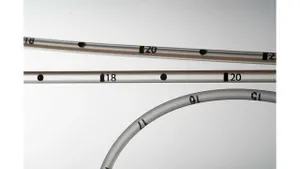Technology Notebook: Optimizing the extrusion process and melt stream
July 7, 2002
Editor?s note: The author, Donald E. De Laney, a consultant in polymer process rheology, worked with GE for 17 years and has worked with Dynisco over the past eight years.
The plastics compounding and extrusion industries are being pushed hard by high resin and labor costs and the demand for superior product performance and consistent quality. This pattern is cutting into the already slim margins of the producers. The survival of many producers of film, sheet, profile, tubing, and pipe now depends on avoiding even the smallest flaw or inconsistency in their products. Unfortunately, even when all of the operational parameters in an extrusion process?pressure, temperature, screw rotation rate, and so on?appear to be under control, the end product may still show inconsistencies or otherwise fail to meet specifications.
|
Figure 1. This diagram of an extrusion line shows the auxiliaries that help improve the melt stream, including pressure transducers, a melt filtration system, a melt pump and static mixer, and an online rheometer. |
The main function of an extruder is to deliver a homogeneous plastic melt to a die at a specified uniform temperature and pressure. To do this, the well-designed extruder is generally equipped with an efficient drive and feeder system, and a screw designed to melt and convey the product. Thermocouples and melt pressure transducers are normally installed to monitor the system for safety and process control.
The extruder, however, is mainly a plastic melting and melt conveying machine, which is sometimes provided with some capacity for mixing. In general, what goes in one end of the extruder is what comes out the other end.
The extrusion process does not improve the quality of the resin fed into the extruder. Even if the feed resin properties are adequate for an application, the resin may be degraded by the presence of contaminants or by exposure to excessive temperatures, pressures, and residence time within the extruder.
However, once material has been melted and mixed within the extruder, the quality and process stability of the resulting melt stream can be precisely controlled and even improved before it is delivered to the die and downstream equipment. The following are some tips for optimizing the process.
Figure 1 shows the locations in the extrusion line of critical pressure transducers and other useful components including a melt filtration system, a melt pump and static mixer, and an online rheometer. These can have a significant impact on the quality of the melt stream. The melt filtration system removes any contaminants and ensures a uniformly clean product. A melt pump and static mixer control the rate, pressure, temperature, and stability of flow of the molten resin to the sheet, film, or pipe die. The online rheometer monitors the melt flow or viscosity of the resin.
|
Figure 2. This breaker-plate mounted screen pack consists of a stack of 20/60/150/20 mesh sizes (from left to right). It is inserted into the melt stream to remove contaminants. |
Melt Filtration
Contamination of the melt stream by metal, paper, wood, or internally generated black specks or gels yields products that are unacceptable in appearance and/or performance. When reclaim is included in the resin feed it is almost impossible to eliminate the introduction of these defects from the process. Thus a breaker-plate mounted screen pack consisting of more than one screen mesh (for example, a stack consisting of 20/60/150/20 mesh sizes) is often inserted into the melt stream to remove contaminants. An example of such a screen pack is shown in Figure 2.
In addition to filtering the molten polymer stream, the screen pack and breaker-plate combination also serves to create backpressure in the extruder, which enhances mixing and melting processes along the screw. Over time, however, the screens become blocked, with a resulting buildup in backpressure. To monitor this buildup, melt pressure transducers are normally placed inline preceding and following the screen pack. Their output may be used to adjust the screw speed to maintain a constant flow to the die. Eventually, the pressure builds up to a point where the productivity and safety of the process become compromised and the screen pack must be changed. This requires shutting down the extruder to remove and replace the contaminated screen pack, with an attendant loss in productivity.
To minimize the loss of production from a screen pack change, semiautomatic and fully automatic screenchanger systems have been developed. These systems generally consist of two or more breaker-plate/screen pack combinations mounted in a precision-machined plate that can slide in and out of the melt stream. The operation of these screenchangers can be performed either manually or hydraulically, in a discrete or continuous manner.
Manual systems are the least expensive and are most suitable for small lines or those requiring infrequent changes. Hydraulic systems are more appropriate for larger extruders with high pressures, and for cases in which changes may be more frequent.
The disadvantage of both of these systems is that they are discontinuous. That is, the screen change causes a momentary interruption in flow, with a resulting pressure drop, that may affect the extrusion of product. This has been overcome with the development of continuous screenchangers that provide uninterrupted flow during the change. These systems can be linked to the output of the pressure transducers to provide an automated screen change when backpressure reaches a specified level.
The lower range for filtration with a screen pack is limited to 42 µm, or 325 mesh, due to the high pressures generated. Screen packs are also frequently incapable of filtering gels, which may break up and pass through rather than being captured by the mesh. To get around this problem, filter media constructed from sintered metal or fiber metal felt are sometimes used.
The design of the filter elements used for these media employ a pleated and flat wrap design that provides a maximum surface area for exposure to the melt. This allows filtration of particulates and gels in the range of 3 to 250 µm at pressures that can be safely achieved in the extrusion process. With all of the options available for filtration, and the possibilities for its automation, a very clean melt can be produced with little or no effect on extrusion rate and a significant improvement in productivity.
Melt Pumps
The stability of the flow of the melt stream has a critical impact on the quality of the extruded product. In a single-screw extruder, the pumping rate can change as the various forces in the screw channel fluctuate, and can substantially decrease as the backpressure increases. However, the stability of the melt pressure, and thus the flow from the extruder, can be greatly improved by the insertion of a melt pump, sometimes called a gear pump, at the extruder outlet, following the melt filter.
|
Figure 3. This diagram shows the operation of a melt pump. The two counter-rotating, intermeshing gears produce a positive volumetric displacement of the melt. The resulting pumping action creates a flow rate that is virtually independent of the discharge pressure. The inlet/outlet melt pressure differential can be as much as 4000 psi, or 275 bar. |
As shown in Figure 3, a melt pump contains two counter-rotating, intermeshing gears that produce a positive volumetric displacement of the melt. This results in a positive pumping action, which creates a flow rate that is virtually independent of the discharge pressure. At the inlet, melt fills the open gear teeth and is positively carried along the walls of the pump cavity and is delivered to the outlet, generating high discharge pressure. The resulting inlet/outlet melt pressure differential can be as much as 275 bar (4000 psi). The pump, which uses a small amount of the molten polymer to lubricate its bearings, must have very tight clearances to minimize leakage at such high pressures. Thus, it is usually located following the screen pack to prevent hard contaminants from reaching the gears or bearings.
Although the feed pressure of the molten polymer from the extruder to the melt pump may fluctuate, the discharge pressure remains virtually constant as long as there is sufficient inlet pressure for melt to fill the gear teeth. A pressure transducer is normally placed at the inlet to ensure that there is sufficient melt pressure to feed the pump. This is critical, as starvation of the pump can lead to inadequate lubrication, resulting in seizure of the bearings. A second pressure transducer is generally inserted at the pump exit to enable control of the outlet pressure.
Melt pressure transducer traces are measured at the screw tip, after the screen pack, and at the melt pump discharge (see Figure 1). The effect of this process stability on an extruded film or sheet can yield a two-to three-fold reduction in product thickness variation, with a resulting improvement in quality and cost reduction.
In addition to precisely controlling the flow, the melt pump also allows the extruder to run at lower head pressures. This reduction in head pressure provides an increase in the specific output rate (output rate per rpm) and a substantial reduction in melt temperature. And lower melt temperatures reduce the chance of thermal degradation during the extrusion process. Thus the melt pump also has an impact on the quality of the molten resin.
Since the melt pump cannot improve thermal uniformity, a static mixer can be placed in the line after the melt pump and before the die. The static mixer consists of a series of stationary mixing elements inserted in the melt stream to disperse the polymer flow. This dispersion of the flow produces a well-mixed melt, with a uniform distribution of temperature, for delivery to the die.
Online Rheometer
The melt flow or viscosity of a polymer melt is also a critical parameter. It not only determines whether or how well a material can be extruded, but it also provides information about the basic molecular structure of the resin. For this reason melt flow measurements are included in the basic tests for the quality control of plastics compounds and resins. Deviations in composition or degradation of the polymer, which may lead to failure of the extruded product, can be predicted by observing changes in the resin or compound?s melt viscosity.
Generally, tests of material flow have been performed in the laboratory and have not been practical for direct process control. However, rheometers are now available that can be interfaced directly with the extrusion process to provide real-time melt flow or viscosity values. These instruments not only serve to monitor the material quality but also provide valuable data for process control.
A return-stream online rheometer, which can weigh just 20 kg, can be interfaced to an extruder through a standard M18 sensor port?without extensive modifications of the processing machinery. Molten polymer flows into the instrument through the central tube of the annular melt transfer line that protrudes into the stream.
The molten polymer is pumped through a capillary die by the first of a pair of stacked melt pumps, which accurately control the rate of polymer flow through the capillary die. After passing through the capillary die, a second stacked melt pump returns the molten polymer to the process through the outer tube of the transfer line.
The temperatures of all of these components are precisely controlled. Very sensitive, melt-pressure transducers are used to measure the pressure drop that occurs as the polymer flows through the capillary. The rpm of the pump and the pressure drop across the capillary are used, together with the die geometry, to calculate the viscosity or the melt-flow rate of the resin. High precision and accuracy are required of the melt-pressure transducers and melt pumps in order to obtain reliable measurements of melt flow or viscosity.
For instance, an online rheometer, used to monitor a polyethylene extrusion process during which an irregularity in a recycle feeder occurred, is able to sense the viscosity change resulting from the process deviation. This enables the operator to make a quick adjustment to avoid extruding a large amount of off-specification product.
The presence of moisture, which causes a degradation of the resin and subsequent failure of the product, is reflected by a low viscosity reading in the online rheometer. This allows the operator to switch to a different source of resin, sufficiently dried, and production can continue. Changes in such variables as the molecular weight or composition of the feed can be seen as an increase or decrease in the viscosity. Even if these changes occur very gradually, they can be observed as a trend in the viscosity value.
Collection of these data over time permits the establishment of critical limits that ensure extrusion of a consistent product. Interfacing of the rheometer output to a computer that contains the established control parameters can then provide automated responses to deviations and provide process control.
Contact Information
Dynisco, Morgantown, PA
Donald E. De Laney
(610) 286-7555
www.dynisco.com
You May Also Like





